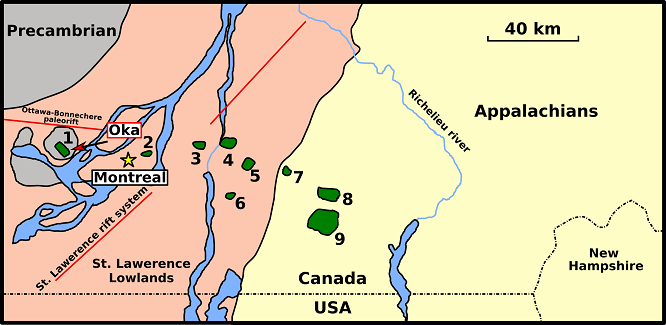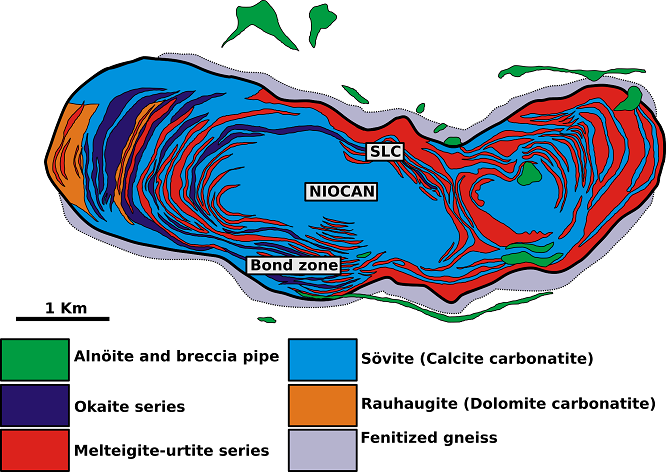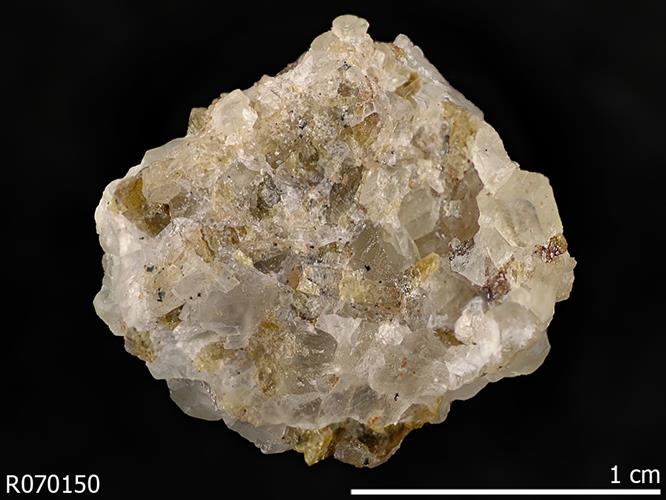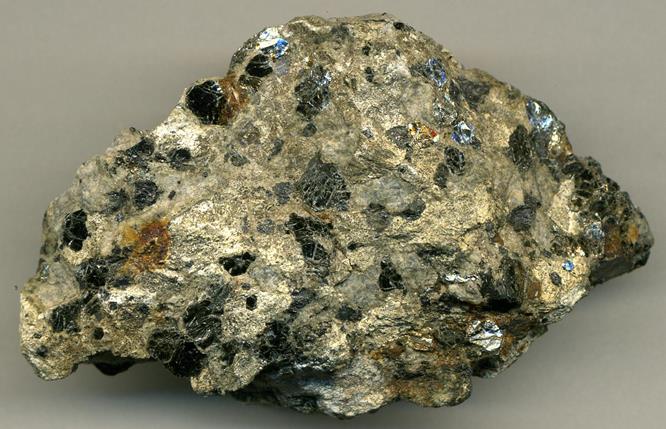The Oka complex
The Monteregian Igneous Province
The Monteregian Igneous Province consists of a series of alkaline plutons and dikes emplaced along a linear east-west trend associated with the St. Lawrence graben and the Ottawa-Bonnechere paleorift (Fig. 1-2). The magmas intruded three different terrains, including the Precambrian Grenville basement west of Montreal, the St. Lawrence Lowlands sediments, and the metamorphosed sequences of the Appalachian Mountains, east of Montréal. From west to east, the igneous intrusions reveal a large variety of rock types from strongly silica-undersaturated to moderately silica-saturated. At the western end of the Monteregian Igneous Province, the Oka complex is characterized by strongly silica-undersaturated rocks, represented by carbonatites (Gold 1963; Gold and Eby 1986)..jpg)
Fig.1: Location of the Monteregian Hills showing the distribution of Cretaceous magmatism and major faults in southern Quebec. From Roulleau, E., & Stevenson, R. (2013)
.jpg)
Fig.2: View from space of Monts St. Hilaire, Rougemont, and Yamaska. Astronaut photograph ISS014-E-19807 acquired April 18, 2007. Image from ISS Crew Earth Observations experiment and the Image Science & Analysis Laboratory, Johnson Space Center. From Wikipedia
The central intrusions of the Monteregian Igneous Province (Mt Royal, St. Bruno, St. Hilaire, St. Grégoire, Yamaska, and Rougemont) are principally composed of slightly silica-undersaturated (nepheline syenite, essexite) to moderately silica-oversaturated rocks (gabbros and pyroxenite) with minor felsic rocks. The eastern part of the Monteregian Igneous Province (Mounts Shefford and Brome) is mainly characterized by silica-oversaturated rocks (syenite) and minor ma?c rocks. Igneous activity extended from 240 to 90 Ma ago with two major periods of magmatism, correlated with events in the opening of the N Atlantic Ocean, occurring between 200–165 Ma and 140–110 Ma ago.
The Oka complex
The Oka complex (Fig.3-4) is amongst the youngest carbonatite occurrences in North America (Shafiquall et al. 1970 document K-Ar ages that range between 107 and 119 Ma) and is associated with the Monteregian Igneous Province (MIP; Quebec, Canada). The Oka complex is a composite pluton emplaced into metamorphic rocks and anorthosite 40 km west of Montreal, Quebec. The complex includes two distinct intrusive centers, which give the complex its figure-eight plan. Both intrusive centers include an earlier outer annulus of alkalic silicate-rich rocks and, and a later central plug of carbonatite. The complex is cut by alnöitic breccia pipes and dikes of dolomitic carbonatite (Treiman and Essene, 1984). The complex is not deformed or metamorphosed and extends along the axis of the Beauharnois arch (a broad northwest-trending arch) in a roughly oval shape. The Oka complex is seven kilometers long by two and a half kilometers wide and is elongate northwest-to-southeast. Gold (1963, 1967, 1972) suggested that it is composed of four plutons in two intrusive centers. Three occurrences of Nb are found at the Oka complex, the St. Lawrence Columbium deposit, the Bond Zone deposit and the NIOCAN deposit (Fig.4).
Fig. 3. Regional map showing distribution of intrusions associated with the Monteregian Igneous Province (MIP). Intrusions identified on the map are: 1-Oka; 2-Royal; 3-Bruno; 4-St. Hilaire; 5-Rougemont; 6-Johnson; 7-Yamaska; 8-Shefford; 9-Brome. Modified from Chen, W., & Simonetti, A. (2014).

Fig. 4. Geological map of the Oka carbonatite complex. The type localities of the Nb deposits within Oka are shown in the map: SLC: St. Lawrence Columbium, NIOCAN: name of mining company with mineral rights, and Bond Zone. Modified from Zurevinski, S. E., & Mitchell, R. H. (2004).
Petrography
The rocks comprising the Oka carbonatite and alkaline complex may be divided into 5 main groups. Most of these rocks are undersaturated meta-aluminum rocks contemporaneous (100 m.y.) with the alkaline rocks of the Monteregian Hills to the east.1) Carbonatites: Carbonatites are a diverse group, but most of the carbonatite in the Oka complex are coarse-grained calcite-carbonatite (sovite) with accessory amounts of sodian augite, biotite, apatite, nepheline, monticellite, melilite, pyrochlore, perovskite, niocalite (Oka is the type locality), richterite, pyrite and pyrrhotite. Dolomite-bearing carbonatites (rauhaugites) occur mainly in the NW end of the complex. Locally the carbonatites become very micaceous (biotite or phlogopite) and qualify as glimmerite. The economically important rocks here are almost all carbonatites, particularly a pyrochlore-sovite in the northern ring.
2) Okaite-jacupirangite series: These consist of a gradational sequence from melilite-rich, through monticellite, nepheline, and haüynite bearing varieties to titanaugite-rich rocks. In places, magnetite is abundant.
3) Ijolite series: includes all rocks consisting essentially of nepheline and sodian augite. These grade from melteigite (pyroxene-rich) through ijolite to urtite (nepheline-rich). In the southern part of the Complex, wollastonite- and melanite-bearing varieties are exposed.
4) Replacement and alteration rocks: occur in zones or discontinuous bands throughout the Complex. Hydrothermal solutions apparently were the agent; the effect was to thoroughly biotitize any silicate rocks encountered. Locally, in sheared zones, the silicate minerals have been partly or completely altered to chlorite, and vugs of pyrite, galena, and calcite are present.
5) Alnöite and basic lamprophyre dikes and plugs: are intruded into the Complex and its border in a remarkably regular pattern. Some of these are texturally and chemically similar to kimberlite.
Ages distribution indicates that alnöite was intruded first, followed by okaite and carbonatite, whereas ijolite defines a bimodal emplacement history. The combined chemical, isotopic, and geochronological data is best explained by invoking the periodic generation of small volume, partial melts generated from heterogeneous mantle. Data and modelling from alkaline rocks of the Monteregian Igneous Province suggest an origin linked to mantle source. The whole-rock chemical composition of the intrusions is consistent with fractional crystallization of an assemblage of olivine ± clinopyroxene (± plagioclase) derived from ocean island basalts (OIB)-like magmas, and variations in the Sr and Nd isotope compositions suggest as much as 20% crustal contamination. Variations in these isotopic compositions along the west-east axis of the Monteregian Province (from the Oka carbonatite to the Mount Shefford intrusion) may re?ect various degrees of mixing between HIMU and EMI enriched mantle reservoirs. Anomalously low 207Pb/204Pb and 208Pb/204Pb isotopic ratios from some of the intrusions likely indicate incorporation of an Archean component within the lithospheric mantle.

Yellow Niocalite crystals in a Carbonatite. Oka complex, Quebec, Canada. Image from RRUFF
.jpg)
Sövite: Cristalli di calcite (bianco), cristalli di pirocloro (scuro) e cristalli di niocalite (giallo). Oka, Quebec, Canada. Immagine tratta da James St. John
.jpg)
Calciocarbonatite (sövite) ominated by calcite (whitish-yellowish), plus some niocalite (yellowish) and pyrochlore (slightly uraniferous (dark). From James St. John
.jpg)
Breccia alnöitica: Cristalli di flogopite (scuro) in una matrice ricca in melilite. Oka, Quebec, Canada. Immagine tratta da James St. John

Okaite from Oka Carbonatite Complex, Early Cretaceous; Oka Niobium Mine, Quebec, Canada. Okaite is a feldspathoidal ultramafic igneous rock composed of nepheline, melilite, biotite mica, plus minor accessory minerals. From James St. John
Bibliography
• Chen, Wei, and Antonio Simonetti. "Evidence for the multi-stage petrogenetic history of the Oka carbonatite complex (Québec, Canada) as recorded by perovskite and apatite." Minerals 4.2 (2014): 437-476.
• Gold, David Percy, and Marcel Vallée. Field Guide to the Oka Area: Description and Itinerary. Vol. 101. Department of Natural Resources, 1969.
• Roulleau, Emilie, and Ross Stevenson. "Geochemical and isotopic (Nd–Sr–Hf–Pb) evidence for a lithospheric mantle source in the formation of the alkaline Monteregian Province (Quebec)." Canadian Journal of Earth Sciences 50.6 (2013): 650-666.
• Shafiqullah, M.; Tupper, W.; Cole, T. K-Ar age of the carbonatite complex, Oka, Quebec. Can. Mineral. 1970, 10, 541–552.
• The Oka Carbonatite Complex, Quebec: deep structure from joint 3D gravity and magnetic data inversion. Sander Geophysics.
• Treiman, Allan H., and Eric J. Essene. "The Oka carbonatite complex, Quebec: geology and evidence for silicate-carbonate liquid immiscibility." American Mineralogist 70.11-12 (1985): 1101-1113.
• Zurevinski, Shannon E., and Roger H. Mitchell. "Extreme compositional variation of pyrochlore-group minerals at the Oka carbonatite complex, Quebec: evidence of magma mixing?." The Canadian Mineralogist 42.4 (2004): 1159-1168.

